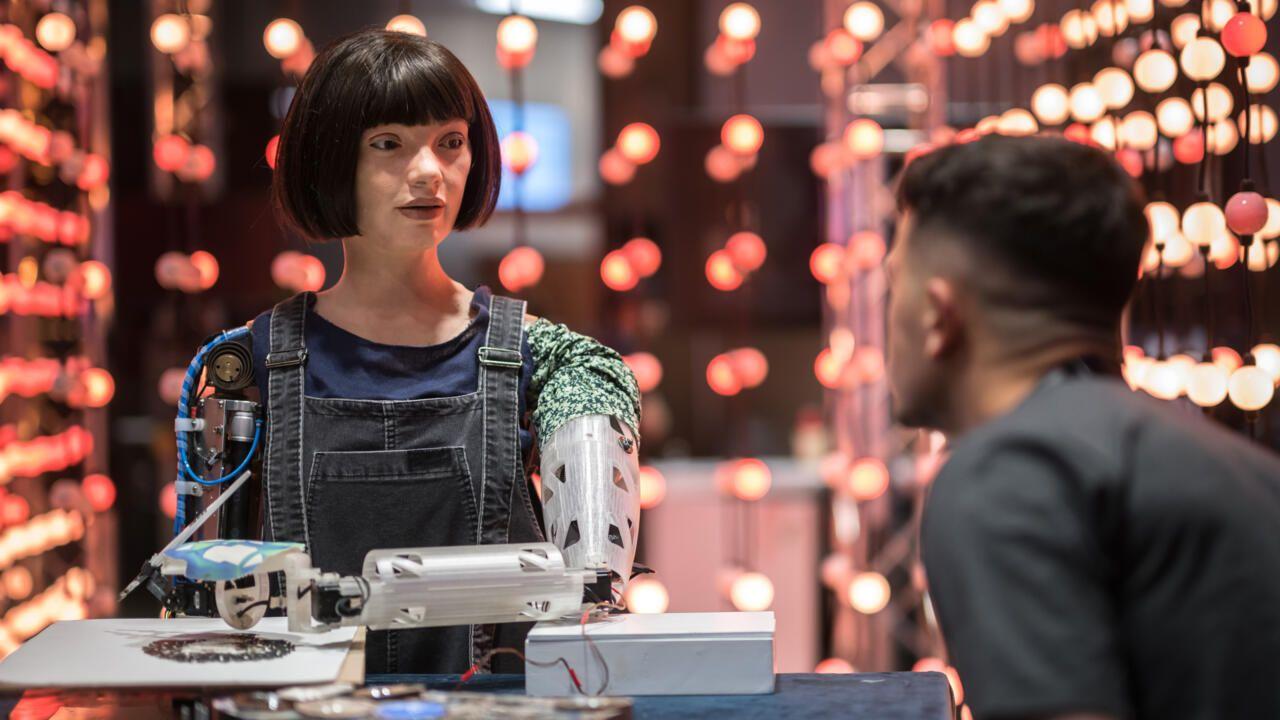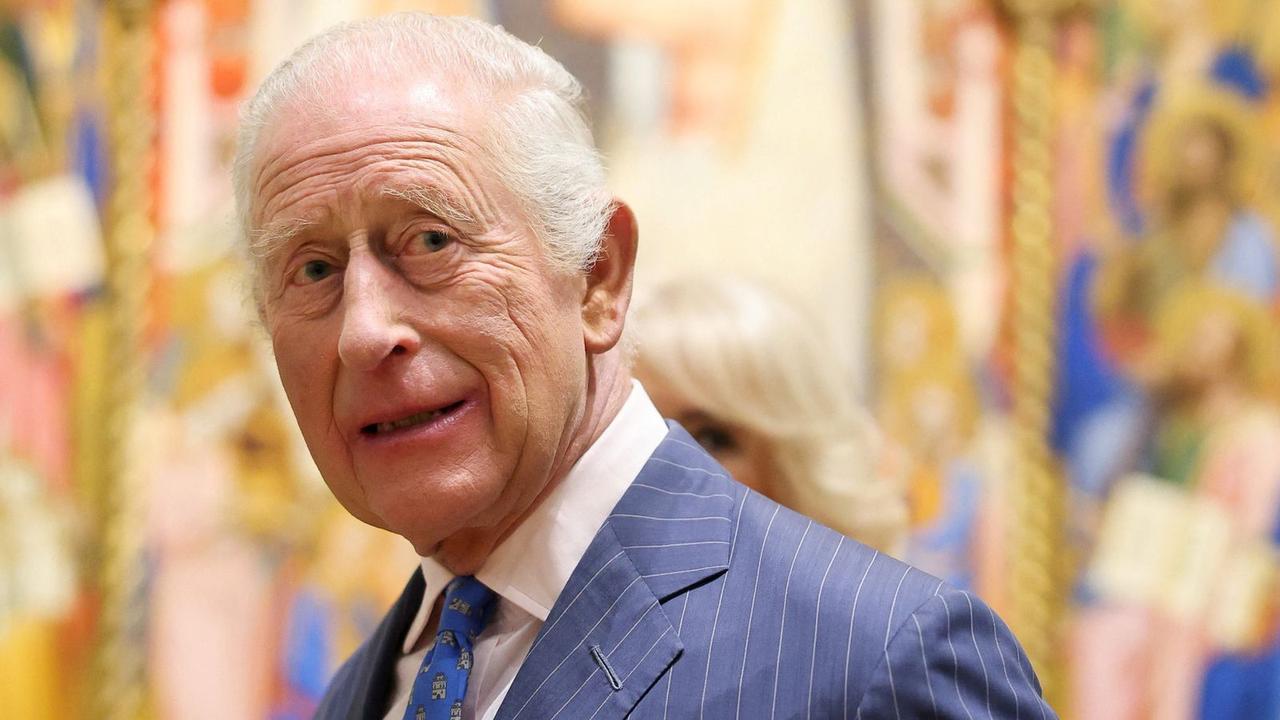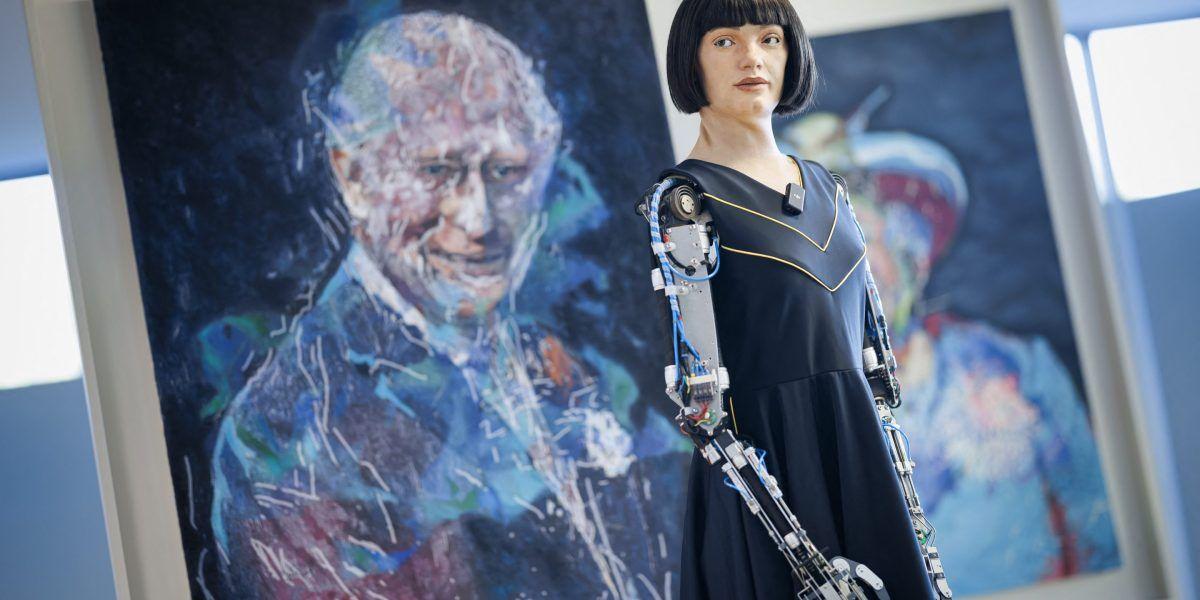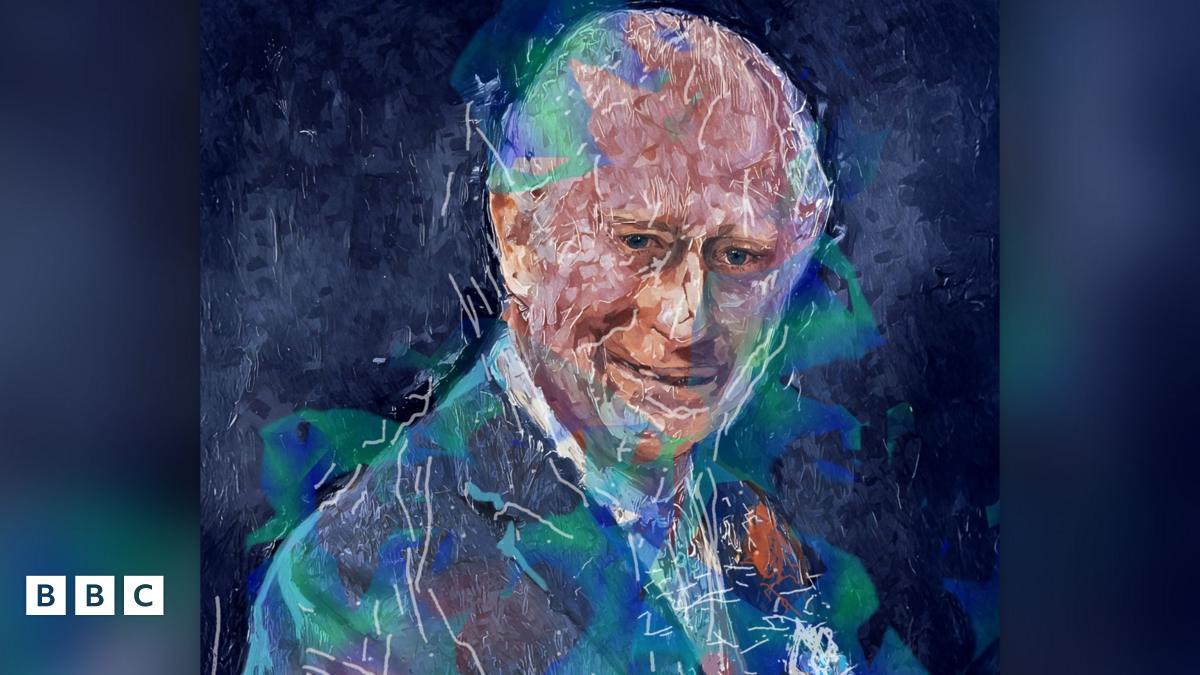AI-Powered Humanoid Robot Ai-Da Creates Portrait of King Charles, Sparks Debate on AI in Art
3 Sources
3 Sources
[1]
Humanoid robot Ai-Da that sold first robot art at auction for over $1 million now says it's not aiming to 'replace human artists'
When successful artist Ai-Da unveiled a new portrait of King Charles this week, the humanoid robot described what inspired the layered and complex piece, and insisted it had no plans to "replace" humans. The ultra-realistic robot, one of the most advanced in the world, is designed to resemble a human woman with an expressive, life-like face, large hazel eyes and brown hair cut in a bob. The arms though are unmistakably robotic, with exposed metal, and can be swapped out depending on the art form it is practicing. Late last year, Ai-Da's portrait of English mathematician Alan Turing became the first artwork by a humanoid robot to be sold at auction, fetching over $1 million. But as Ai-Da unveiled its latest creation -- an oil painting entitled "Algorithm King", conceived using artificial intelligence -- the humanoid insisted the work's importance could not be measured in money. "The value of my artwork is to serve as a catalyst for discussions that explore ethical dimensions to new technologies," the robot told AFP at Britain's diplomatic mission in Geneva, where the new portrait of King Charles will be housed. The idea, Ai-Da insisted in a slow, deliberate cadence, was to "foster critical thinking and encourage responsible innovation for more equitable and sustainable futures". Speaking on the sidelines of the United Nations' AI for Good summit, Ai-Da, who has done sketches, paintings and sculptures, detailed the methods and inspiration behind the work. "When creating my art, I use a variety of AI algorithms," the robot said. "I start with a basic idea or concept that I want to explore, and I think about the purpose of the art. What will it say?" The humanoid pointed out that "King Charles has used his platform to raise awareness on environmental conservation and interfaith dialog. I have aimed this portrait to celebrate" that, it said, adding that "I hope King Charles will be appreciative of my efforts". Aidan Meller, a specialist in modern and contemporary art, led the team that created Ai-Da in 2019 with artificial intelligence specialists at the universities of Oxford and Birmingham. He told AFP that he had conceived the humanoid robot -- named after the world's first computer programmer Ada Lovelace -- as an ethical arts project, and not "to replace the painters". Ai-Da agreed. There is "no doubt that AI is changing our world, (including) the art world and forms of human creative expression", the robot acknowledged. But "I do not believe AI or my artwork will replace human artists". Instead, Ai-Da said, the aim was "to inspire viewers to think about how we use AI positively, while remaining conscious of its risks and limitations". Asked if a painting made by a machine could really be considered art, the robot insisted that "my artwork is unique and creative". "Whether humans decide it is art is an important and interesting point of conversation."
[2]
Humanoid robot says not aiming to 'replace human artists'
Geneva (AFP) - When successful artist Ai-Da unveiled a new portrait of King Charles this week, the humanoid robot described what inspired the layered and complex piece, and insisted it had no plans to "replace" humans. The ultra-realistic robot, one of the most advanced in the world, is designed to resemble a human woman with an expressive, life-like face, large hazel eyes and brown hair cut in a bob. The arms though are unmistakably robotic, with exposed metal, and can be swapped out depending on the art form it is practicing. Late last year, Ai-Da's portrait of English mathematician Alan Turing became the first artwork by a humanoid robot to be sold at auction, fetching over $1 million. But as Ai-Da unveiled its latest creation -- an oil painting entitled "Algorithm King", conceived using artificial intelligence -- the humanoid insisted the work's importance could not be measured in money. "The value of my artwork is to serve as a catalyst for discussions that explore ethical dimensions to new technologies," the robot told AFP at Britain's diplomatic mission in Geneva, where the new portrait of King Charles will be housed. The idea, Ai-Da insisted in a slow, deliberate cadence, was to "foster critical thinking and encourage responsible innovation for more equitable and sustainable futures". 'Unique and creative' Speaking on the sidelines of the United Nations' AI for Good summit, Ai-Da, who has done sketches, paintings and sculptures, detailed the methods and inspiration behind the work. "When creating my art, I use a variety of AI algorithms," the robot said. "I start with a basic idea or concept that I want to explore, and I think about the purpose of the art. What will it say?" The humanoid pointed out that "King Charles has used his platform to raise awareness on environmental conservation and interfaith dialog. I have aimed this portrait to celebrate" that, it said, adding that "I hope King Charles will be appreciative of my efforts". Aidan Meller, a specialist in modern and contemporary art, led the team that created Ai-Da in 2019 with artificial intelligence specialists at the universities of Oxford and Birmingham. He told AFP that he had conceived the humanoid robot -- named after the world's first computer programmer Ada Lovelace -- as an ethical arts project, and not "to replace the painters". Ai-Da agreed. There is "no doubt that AI is changing our world, (including) the art world and forms of human creative expression", the robot acknowledged. But "I do not believe AI or my artwork will replace human artists". Instead, Ai-Da said, the aim was "to inspire viewers to think about how we use AI positively, while remaining conscious of its risks and limitations". Asked if a painting made by a machine could really be considered art, the robot insisted that "my artwork is unique and creative". "Whether humans decide it is art is an important and interesting point of conversation."
[3]
The King and AI: A humanoid robot has painted a picture of Charles. How did it do?
The artistic humanoid used advanced artificial intelligence algorithms and a robot arm using on oil canvas to create the image. Whether or not the UK will have a Royal Family in the future is something that often comes up in debate. If we do, the latest evidence suggests there will be no lack of artists around to paint them. A new portrait titled "Algorithm King" has perhaps offered a glimpse of how members of the Royal Family may be painted in the decades or even centuries ahead - after it was created by a female "robot artist" named Ai-Da. The artistic humanoid used advanced artificial intelligence (AI) algorithms and a robot arm using on oil canvas to create the painting of King Charles. Ai-Da, the first robot to ever paint the monarch, also used the cameras in her eyes to help create her machine-made masterpiece. The robot previously painted a portrait of the late Queen Elizabeth II to celebrate the monarch's Platinum Jubilee in 2022. The two portraits, which the monarchs didn't sit for, were exhibited together at an unveiling of the portrait of King Charles as part of the AI For Good Summit hosted by the United Nations in Geneva. Ai-Da, described as being the world's first "ultra-realistic robot artist", was created by UK art dealer Aidan Meller and built in Cornwall by Engineered Arts. She uses advanced AI language modelling to enable her to have a conversation with humans. Speaking at the UN, Ai-Da said: "It's a privilege to be part of this remarkable event at the United Nations, surrounded by those shaping the future of technology and culture. Presenting my portrait of His Majesty King Charles III is not just a creative act, it's a statement about the evolving role of AI in our society, and to reflect on how artificial intelligence is shaping the cultural landscape." Read more from Sky News: Humanoid machine performs real-world task Palace confirms date of Trump's state visit Simon Manley, ambassador and permanent representative to the World Trade Organisation and UN in Geneva, said at the unveiling of the portrait: "Ai-Da is not just a technological marvel, she is a cultural conversation starter. We are proud to showcase British innovation at its most imaginative, and to reflect on how emerging technologies can shape global dialogues on art, ethics and identity." Ai-Da - named after the first computer programmer Ada Lovelace - has spoken at the House of Lords, Number 10 Downing Street and at the UN. Her artwork has been exhibited all over the world from the Tate Modern, V&A, Somerset House and the Design Museum in Britain to the Pyramids in Egypt and the Venice Biennale. She made history in 2024 when a painting by her sold at Sotheby's for $1m. Mr Meller said: "The greatest artists in history grappled with their period of time, and both celebrated and questioned society's shifts. Ai-Da Robot as technology, is the perfect artist today to discuss the current developments with technology and its unfolding legacy."
Share
Share
Copy Link
Ai-Da, an advanced humanoid robot artist, unveils a new portrait of King Charles, raising questions about AI's role in art and its impact on human creativity.
The Rise of AI in Art: Ai-Da's Royal Portrait
In a groundbreaking development at the intersection of artificial intelligence and art, Ai-Da, an advanced humanoid robot artist, has unveiled a new portrait of King Charles titled "Algorithm King"
1
. This ultra-realistic robot, designed to resemble a human woman, has sparked intense debate about the role of AI in creative expression and its potential impact on human artists.Ai-Da: The Artist Behind the Algorithm

Source: France 24
Ai-Da, created in 2019 by a team led by art specialist Aidan Meller, is equipped with advanced AI algorithms and robotic arms capable of producing various forms of art
2
. Named after Ada Lovelace, the world's first computer programmer, Ai-Da has already made history by selling the first artwork by a humanoid robot at auction for over $1 million – a portrait of mathematician Alan Turing1
.The Creation of "Algorithm King"
The portrait of King Charles, an oil painting conceived using artificial intelligence, was unveiled at Britain's diplomatic mission in Geneva during the United Nations' AI for Good summit
2
. Ai-Da explained its creative process, stating, "When creating my art, I use a variety of AI algorithms. I start with a basic idea or concept that I want to explore, and I think about the purpose of the art"1
.
Source: Sky News
AI and the Future of Art
Despite its success, Ai-Da insists that its purpose is not to replace human artists but to "serve as a catalyst for discussions that explore ethical dimensions to new technologies"
2
. The robot acknowledges the transformative impact of AI on the art world but emphasizes its role in inspiring critical thinking about the positive use of AI while remaining conscious of its risks and limitations1
.Related Stories
The Debate: Machine vs. Human Creativity
The creation of "Algorithm King" has reignited discussions about the nature of art and creativity in the age of AI. While Ai-Da asserts that its artwork is "unique and creative," it also acknowledges that whether humans consider it art is "an important and interesting point of conversation"
2
. This raises profound questions about the definition of art and the role of human intention and emotion in the creative process.Ai-Da's Growing Influence

Source: Fortune
Ai-Da's influence extends beyond the art world. The robot has spoken at prestigious venues such as the House of Lords, 10 Downing Street, and the UN
3
. Its artwork has been exhibited globally, from the Tate Modern and V&A in Britain to the Pyramids in Egypt and the Venice Biennale, demonstrating the growing acceptance and interest in AI-generated art3
.As AI continues to evolve and integrate into various aspects of human creativity, the conversation sparked by Ai-Da and "Algorithm King" is likely to intensify, challenging our perceptions of art, technology, and the nature of creativity itself.
References
Summarized by
Navi
Related Stories
AI Robot Artist Ai-Da Unveils Portrait of King Charles III at UN Summit
18 Jul 2025•Technology

AI-Powered Robot Artist Ai-Da's Portrait of Alan Turing Sells for $1 Million at Sotheby's Auction
08 Nov 2024•Technology

Sotheby's to Auction First Artwork by Humanoid Robot Ai-Da, Challenging Art World Norms
16 Oct 2024•Technology

Recent Highlights
1
Google launches Gemini 3 Flash as default AI model, delivering speed with Pro-grade reasoning
Technology

2
OpenAI launches GPT Image 1.5 as AI image generator war with Google intensifies
Technology

3
OpenAI launches ChatGPT app store, opening doors for third-party developers to build AI-powered apps
Technology





